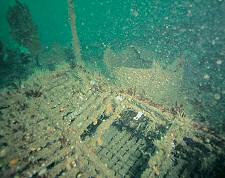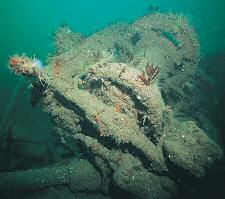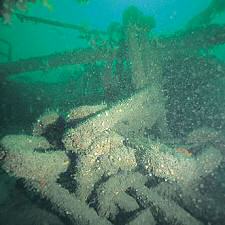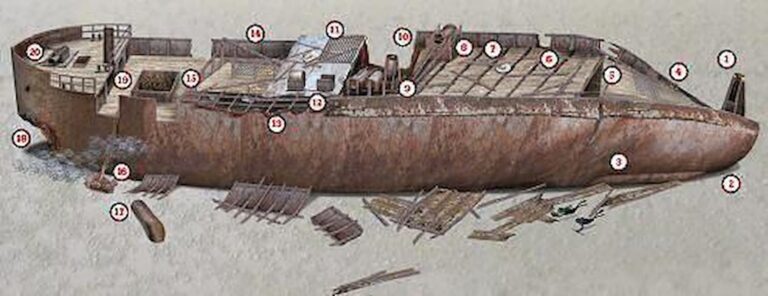One of Northern Ireland’s most popular wrecks, a ferry that was working as a troopship when she was sunk in World War Two, lies near Rathlin Island. The wreck’s bathroom fittings are just part of the attraction, says JOHN LIDDIARD. Illustration by MAX ELLIS
ON AN UPRIGHT WRECK SUCH AS THE LOCHGARRY, resting as it does on a flat seabed, there is plenty of choice of targets at which to aim the shot. So, purely for my convenience, our tour will begin at the stern, the end of the wreck closest to Rathlin Island.
Over the past few years the stern has begun to split from the main body of the wreck and fall to starboard, leaving the gun-mount (1) pointing out at an angle.
Below the stern, the twisting of the hull has left a recess between the hull and the seabed (2), though the propeller-shaft is well-buried (3).
Returning to the deck, on the starboard side of the stern it almost touches the seabed. Forward of the gun-mount, the wooden deck is split and stretched across the deck-beams where the wreck has twisted.

To either side, small pairs of bollards (4) are held in place by their mounting-plates being attached to the sides of the hull.
As an ex-ferry in service as a troopship during WW2, the Lochgarry was fitted with all the facilities necessary to accommodate passengers.
The first sign of these is an area of black-and-white diagonally checked tiles from a toilet or bathroom floor, just behind where the sloping stern meets the still-level main deck (5). The Lochgarry had a second passenger deck running the full width of the hull above the main deck. Now it has collapsed almost level with the main deck, though a little bit further on it has collapsed to the starboard side (6).

Continuing forward and close to the centre-line, another remnant of the passenger facilities is a slab of white porcelain from a sink or toilet (7).
Getting away from the passenger facilities, just aft of the engine-room to the starboard side of the wreck is the base of a cargo-handling crane (8). Its jib runs out across the wreck.

The engine-room is open above, with the Lochgarry’s triple-expansion steam engine fully exposed (9). The aftmost low-pressure cylinder is upright, while forward of this the intermediate and high-pressure cylinders have fallen as a pair to port.
Except for the now-falling stern, the starboard side of the engine-room is the only area of hull to have collapsed (10). The break is so clean that I suspect it was engineered to salvage the condenser from the base of the engine.
Forward of the engine-room, the main deck continues with the upper deck collapsed almost level with it. The boiler is below and can be seen by looking forward through the bulkhead from the engine-room.
Again just to the starboard side, another region of black-and-white diagonally checked tiles marks the location of one of the toilets (11). Just next to this is a broken slab of white porcelain from a toilet or sink.
Crossing towards the port side, a box structure (12) is the base from a water-tank. Immediately forward of this, a second such structure still has the water-tank in place above it.
As on the aft part of the wreck, the upper deck has collapsed further to starboard. In this area it leaves a small gap to the port side where it is possible to look in at the remnants of fittings between the decks (13). It will by now come as little surprise that the most recognisable items sandwiched between the decks are yet more bathroom fittings.
Crossing the deck again and continuing forwards, two rows of uprights along the deck would have held the wheelhouse. Then we have the final sign of our bathroom theme, another region of those diagonally checked tiles (14).
Forward of the wheelhouse is the recess for the Lochgarry’s main hold, cut down one deck with a higher-than-usual coaming around the hatch (15). Descending inside, the width of the hold is covered in a deep pile of heavy chain, poured in by the Royal Navy as the easiest way to prevent access to the small arms and hand-grenades carried below.
The chain continues up across the deck and over the side, through one of two cut-outs in the port side, and down to a large anchor on the seabed beside the hull (16).
While at 32m on the seabed, a little further out and a couple of metres aft is the tubular cover from a ventilator (17). Right at the bottom of the bow, a significant chunk has been stoved in (18) from where the Lochgarry steamed into the rocks off Torr Point.
Following the chain back to the deck, the back of the forecastle is open, divided by uprights supporting the bow deck (19). There is easy access inside, with plenty of light from above and the sides. Above, the bow deck is complete with all its fittings, from several sets of bollards to railings across the back and partway along each side.

The anchor-winch (20) is well forward on the bow. The anchors were both dropped to keep the Lochgarry in place when the order was given to abandon ship.
With the Lochgarry being just about the most popular wreck in the area, the sea above it can be busy with dive-boats, especially at weekends. Even if decompression is not required, a delayed SMB is recommended for the ascent.
MOTHER OF ALL GALES
AT THE OUTBREAK OF WAR IN 1939, many of the well-known David McBrayne Scottish ferry company ships were commandeered for war service, writes Kendall McDonald. But the 1670 ton, 81m Lochgarry was not to survive the war.
She had been turned into a troopship, but little alteration was needed. Carrying men to the outer islands needed a stout, seaworthy ship and Lochgarry was all of that, working well for McBrayne in the stormy Hebridean waters. On 21 January, 1942, she sailed from Glasgow for Oban, where she was to pick up some troops to garrison the lonely Faroes.
The British soldiers were to prevent any German attempt to turn those islands into a base or supply point for German U-boats, which were already creating havoc with convoys crossing the North Atlantic.
Lochgarry sailed into one of the biggest gales ever to hit the North Channel between Scotland and Northern Island. The wind literally blew her onto the rocks of Rathlin Island, just off the coast of Antrim.
She struck at Torr Point, just a mile east of Rue Point on Rathlin. She was driven so hard that it was all her skipper could do to put her astern and get a little way off the rocks before it was clear that she was sinking rapidly. There was no time for anything but to get the 59 crew into the lifeboats and make for shore.
The first two boats with 30 aboard made it. The third hit a rock and capsized, drowning all 29 occupants. Huge waves made short work of the Lochgarry, and in minutes she was blown over deeper water and sank.
TOUR GUIDE
GETTING THERE: Norfolkline Irish Sea Ferry Services, Liverpool (Birkenhead) to Belfast, 0870 600 4321. From Belfast take the M2, A26 and A2 to Portstewart.
TIDES: The best slack water is two hours before low-water Belfast. There is also a shorter slack about three hours before high-water Belfast.
HOW TO FIND IT: The Lochgarry lies with the bow just south of east. The GPS co-ordinates are 55 15.957N, 6 10.436W (degrees, minutes and decimals).
DIVING, AIR & ACCOMMODATION: Aquaholics, 028 70832584.
LAUNCHING: There is a large public slip at Ballycastle.
QUALIFICATIONS: Not a difficult wreck to dive, but the depth requires at least PADI Advanced or BSAC Sports qualifications.
FURTHER INFORMATION: Admiralty Chart 2798, Lough Foyle to Sanda Island including Rathlin Island, Shipwreck Index of Ireland by Richard and Bridget Larn, Shipwrecks of the Irish Coast by Edward J Bourke, Shipwrecks of the Ulster Coast by Ian Wilson, The Harsh Winds of Rathlin by Tommy Cecil, Diving Ireland, Irish Wrecks Online by Randall Armstrong.
PROS: Lots of stuff to look at in addition to the usual wreck features.
CONS: Can be busy with dive-boats above, especially at weekends.
Thanks to Richard Lafferty & David and Tony Vincent.
Appeared in DIVER March 2006
Other Northern Ireland Wreck Tours on Divernet: Alastor, Bangor, Castle Eden, Hunsdon, Neotsfield, William Mannell

